NCERT Solutions for Class 11 Biology Chapter 20 Locomotion and Movement
These Solutions are part of NCERT Solutions for Class 11 Biology. Here we have given NCERT Solutions for Class 11 Biology Chapter 20 Locomotion and Movement.
Question 1.
Draw the diagram of a sarcomere of skeletal.
Solution:

Question 2.
Define sliding filament theory of muscle contraction.
Solution:
The mechanism of muscle contraction is best explained by the sliding filament theory which states that contraction of a muscle fiber takes place by sliding of the thin filaments over the thick filaments.
Question 3.
Describe the important steps in muscle contraction.
Solution:
Muscle contraction is initiated by a signal sent by the central nervous system (CNS) via a motor neuron. A motor neuron along with the muscle fibers connected to it constitutes a motor unit. The junction between a motor neuron and the sarcolemma of the muscle fiber is called the neuromuscular junction or motor-end plate. A neural signal reaching this junction releases a neurotransmitter (Acetylcholine) which generates an action potential in the sarcolemma. This spreads through the muscle fiber and causes the release of calcium ions into the sarcoplasm. An increase in Ca++ level leads to the binding of calcium with a subunit of troponin on actin filaments and thereby removes the masking of active sites for myosin.
Utilizing the energy from ATP hydrolysis, the myosin head now binds to the exposed active sites on actin to form a cross bridge. This pulls the attached actin filaments towards the center of the A-bonds. The Z-line attached to these actions is also pulled inwards thereby causing a shortening of the sarcomere i.e., contraction. It is clear from the above steps, that during shortening of the muscle i.e., contraction, the ‘I’ bonds are getting reduce whereas the A-bonds are retaining the length. The myosin, releasing the ADP and p1 goes back to its relaxed state.
A new ATP binds and the cross-bridge is broken. This causes the return of Z-lines back to their original position i.e., relaxation. The reaction time of the fibers can vary in different muscles. Repeated activation of the muscles can lead to the accumulation of lactic acid due to the anaerobic breakdown of glycogen in them, causing fatigue. Muscle contains a red-colored oxygen storing pigment called myoglobin. Myoglobin content is high in some of the muscles which gives a reddish appearance. Such muscles are called the Red muscles. These muscles also contain plenty of mitochondria which can utilize a large amount of oxygen stored in them for ATP production.
These muscles, therefore, can also be called aerobic muscles. On the other hand, some of the muscles possess a very little quantity of myoglobin and therefore, appear pale or whitish. These are the white fibers. The number of mitochondria is also few in them, but the amount of sarcoplasmic reticulum is high. They depend on the anaerobic process for energy.
Question 4.
Write true or false. If false, change the statement so that it is true.
- Actin is present in the thin filament.
- H-zone of striated muscle fibre represents both thick and thin filaments.
- The human skeleton has 206 bones.
- There are 11 pairs of ribs in man.
- The sternum is present on the ventral side of the body.
Solution:
- True
- False: The H-zone of striated muscle fibre represents only thick filaments.
- True
- False: There are 12 pairs of ribs in man.
- True
Question 5.
Write the differences between.
(a) Actin and Myosin
(b) Red and White muscles
(c) Pectoral and Pelvic girdle
Solution:
(a) Differences between actin and myosin are as following;

(b) The main difference between red muscles and white muscles are as following :

(c) The main difference between the pectoral girdle and pelvic girdle are as following:
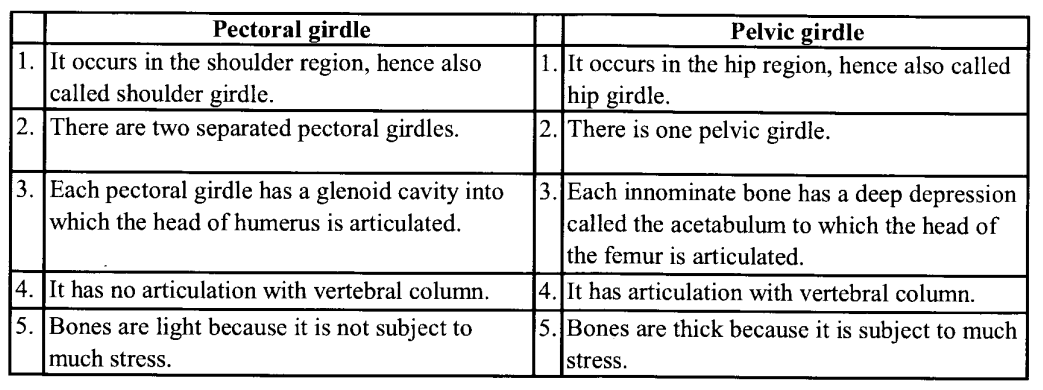
Question 6.
Match Column I with Column II
Column I Column II
(a) Smooth muscle (i) Myoglobin
(b) Tropomyosin (ii) Thin filament
(c) Red muscle (iii) Sutures
(d) Skull (iv) Involuntary
Solution:
(a)– (iv)
(b)-(ii)
(c) -(i)
(d) – (iii)
Question 7.
What are the different types of movements exhibited by the cells of the human body?
Solution:
Cells of the human body exhibit three main types of movements, namely, amoeboid, ciliary and muscular. Some specialized cells in our body like macrophages and leucocytes in blood exhibit amoeboid movement. It is affected by pseudopodia formed by the streaming of protoplasm (as in Amoeba). Cytoskeletal elements like microfilaments are also involved in the amoeboid movement.
Ciliary movement occurs in most of our internal tubular organs which are lined by ciliated epithelium. The coordinated movements of cilia in the trachea help us in removing dust particles and some of the foreign substances inhaled along with the atmospheric air. Passage of ova through the female reproductive tract is also facilitated by the ciliary movement. Movement of our limbs, jaws, tongue, etc, requires muscular movement. The contractile property of muscles is effectively used for locomotion and other movements by human beings and the majority of multicellular organisms. Locomotion requires a perfect coordinated activity of muscular, skeletal, and neural systems.
Question 8.
How do you distinguish between a skeletal muscle and a cardiac muscle?
Solution:
The main difference between skeletal muscle and cardiac muscle are as following:
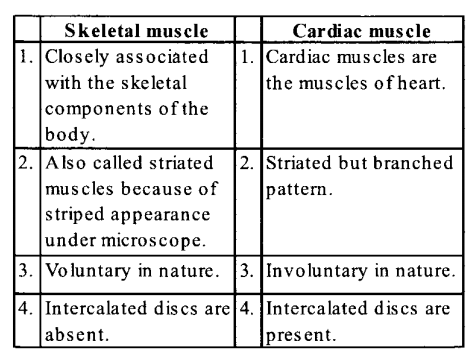
Question 9.
Name the type of joint between the following:
(a) Atlas/Axis
(b) Carpal/metacarpal of the thumb
(c) Between phalanges
(d) Femur/acetabulum
(e) Between cranial bones
(f) Between pubic bones in the pelvic girdle
Solution:
(a) Pivot joint
(b) Saddlejoint
(c) Gliding joint
(d) Ball and socket joint
(e) Fibrous joint
(f) Cartilagenousjoint
Question 10.
Fill in the blank spaces:
(a) All mammals (except a few) have ………….. cervical vertebra.
(b) The number of phalanges in each limb of a human is …………
(c) Thin filament of myofibril contains 2 ‘F’ actins and two other proteins namely ………. and ……………….
(d) In a muscle fibre Ca++ is stored in ……………
(e) …….. and ……….. pairs of ribs are called floating ribs.
(f) The human cranium is made of ……………. bones.
Solution:
(a) Seven
(b) Fourteen
(c) Troponin, tropomyosin
(d) Sarcoplasmic reticulum
(e) 11th, 12th
(f) Eight
VERY SHORT ANSWER QUESTIONS
Question 1.
What causes gouty arthritis in humans?
Solution:
Gouty arthritis (= Gout) is caused either due to excessive formation of uric acid or inability to excrete it.
Question 2.
How many tarsals are there in the ankle?
Solution:
Seven.
Question 3.
What are the bones of the heel called?
Solution:
Metatarsals.
Question 4.
How many types of movement shows by the human body?
Solution:
Three types of movements: amoeboid, ciliary, and muscular movement.
Question 5.
Name the lubricant which is responsible for the movable joint at the shoulder.
Solution:
Synovial fluid.
Question 6.
Give two disorders of skeleton and joints.
Solution:
Arthritis and Osteoporosis.
Question 7.
Mention two sites on all bodies where striated muscles are present.
Solution:
Limbs and tongue.
Question 8.
Name the two filaments which form the cross-bridges during muscle contraction?
Solution:
Actin and myosin.
Question 9.
Name the monomers of myosin.
Solution:
Meromyosins.
Question 10.
How many ribs are present in adult men?
Solution:
Twelve pairs.
Question 11.
Name the single U-shaped bone present at the base of the buccal cavity.
Solution:
Hyoid.
Question 12.
Name the location where Z-line is present in the sarcomere.
Solution:
Centre of I band.
Question 13.
What is the total number of bones present in the left pectoral girdle and the left arm respectively in a normal human?
Solution:
Left pectoral girdle – 2
Left-arm – 30
Question 14.
Name the kind of joint which permits movements in a single plane only.
Solution:
Hinge joint.
Question 15.
What are neuromuscular junctions?
Solution:
The junction between a motor neuron and the sarcolemma of a muscle fiber is known as the neuromuscular junction.
Question 16.
Why are the ribs described as bicephalic?
Solution:
Since each rib has two articulation surfaces on its dorsal end, it is described as bicephalic.
Question 17.
What is acromion?
Solution:
It is a flat expanded process projecting from the spine of the scapula; the clavicle articulates with it.
Question 18.
What is arthritis?
Solution:
Arthritis is painful stiffness and inflammation of joints.
Question 19.
What is sarcomere?
Solution:
A sarcomere is a structural unit within a microfibril bounded by Z lines that contain actin and myosin.
Question 20.
Which muscle protein acts as ATPase?
Solution:
Myosin.
SHORT ANSWER QUESTIONS
Question 1.
What causes osteoporosis?
Solution:
Osteoporosis is a disease in which bone loses minerals and fibres from its matrix. There are more chances of fractures. Decreased level of estrogen is a common cause.
Question 2.
Why a red muscle fibre can work for a prolonged period, while a white muscle fiber suffers from fatigue soon?
Solution:
Red muscle fibres contain myoglobin that stores oxygen in the form of oxymyoglobin.
Since, there is a continuous supply of oxygen; for the oxidation of food materials to release energy, the red muscle fibers retain energy and do not become fatigued and work for long periods whereas white muscle fibres lack myoglobin. At times they carry out anaerobic respiration and become fatigued.
Question 3.
Name the major components of the appendicular skeleton.
Solution:
It is situated at the lateral sides which actually extend outwards from the principal axis. It consists of pectoral and pelvic girdles and bones of arms and legs.
Question 4.
What is the sarcoplasmic reticulum? What is its function?
Solution:
The endoplasmic reticulum of muscle fiber is called the sarcoplasmic reticulum which acts as a storehouse of calcium ions.
Question 5.
Differentiate between A and I bands.
Solution:
The main differences between A-band and I-band are as following :
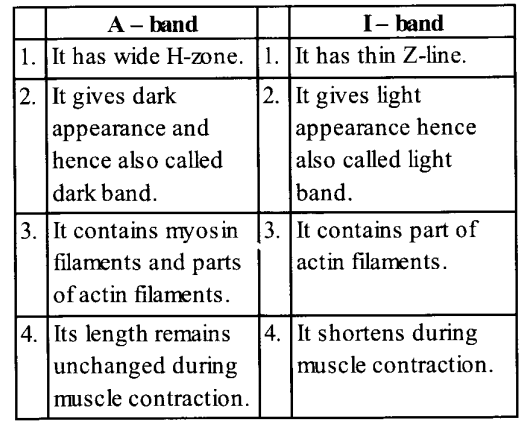
Question 6.
Draw the labeled diagram of the pectoral girdle and upper arm.
Solution:
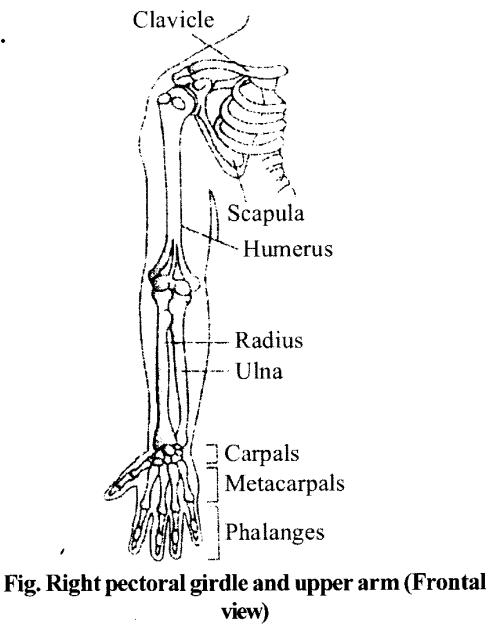
Question 7.
Differentiate between bone and cartilage.
Solution:
The main differences between bone and cartilage are as following:
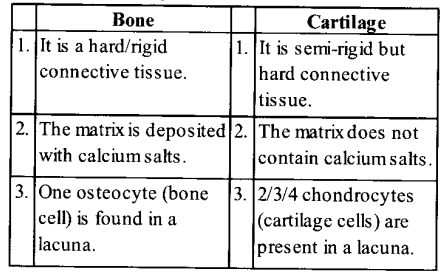
Question 8.
Describe the vertebro-chondral ribs.
Solution:
Vertejno-chondral ribs
- 8th, 9th and 10th pairs of ribs are called vertebro-chondral (false) ribs.
- They remain attached dorsally to the respective thoracic vertebrae and vertrally to the sternum through the seventh rib by hyaline cartilage.
Question 9.
How muscular contraction is triggered?
Solution:
It is triggered by nerve releasing a neurotransmitter, which in turn triggeres the sarcoplasmic reticulum to release calcium ions into muscle interior. Where they bind to troponin, thus causing tropomyosin to shift from the face of the actin filament to which myosin heads need to produce a contraction.
Long ANSWER QUESTIONS
Question 1.
Draw a well diagram of human skull.
Solution:
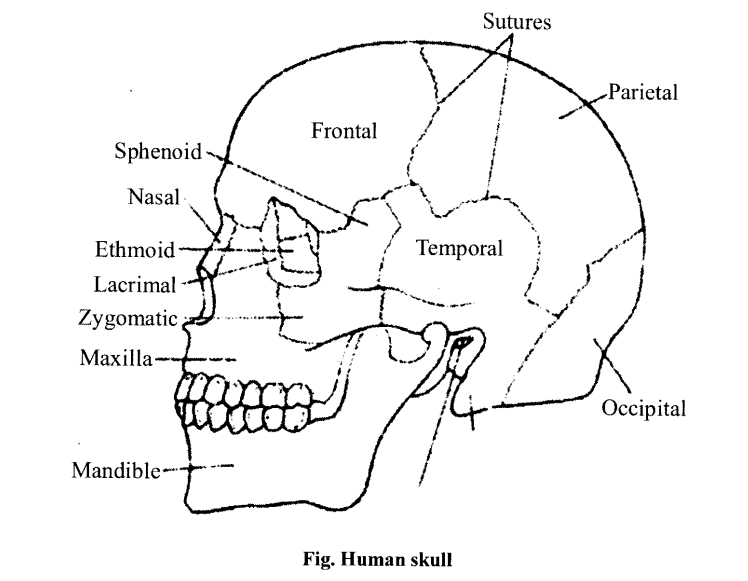
Question 2.
Write short notes on:
(a) Muscular dystrophy
(b) Tetany
(c) Myasthenia gravis
Solution:
Muscular dystrophy
The abnormality of muscles associated with dysfunction and ultimately deterioration is called muscular dystrophy. It is a genetic disorder caused by lack of dystrophin.
Myasthenia gravis: It is an auto-immune disorder that affecting neuromuscular junction and leads to fatigue, weakening, and paralysis of skeletal muscles. ‘
Tetany: The rapid spasm and (wild contractions) is called tetany. In this case, the muscles do not get a chance to relax at all. It is caused due to deficiency of parathyroid hormone and thus lowering Ca++ in blood fluid.
Question 3.
Give differences between movable and immovable joints?
Solution:
Differences between movable and immovable joint are tabulated below:
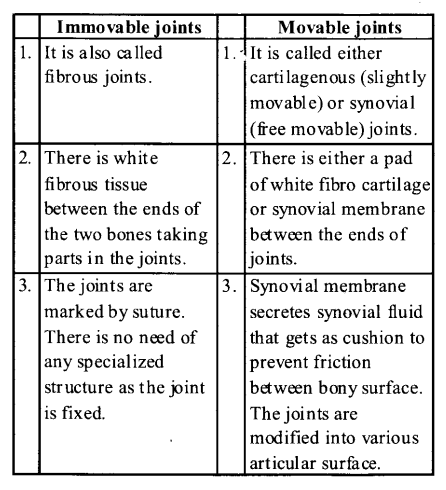
Question 4.
Describe the structure of the rib cage of a human.
Solution:
Rib Cage: There are 12 pairs of ribs. Each rib is a thin flat bone connected dorsally to the vertebral column and ventrally to the sternum. It has two articulation surfaces on its dorsal end and is hence called bicephalic. First, seven pairs of ribs are called true ribs.
Dorsally, they are attached to the thoracic vertebrae and ventrally connected to the sternum with the help of hyaline cartilage. The 8th, 9th, and 10th pairs of ribs do not articulate directly with the sternum but join the seventh rib with the help of hyaline cartilage. These are called vertebrochondral (false) ribs. The last 2 pairs (11th and 12th) of ribs are not connected ventrally and are, therefore, called floating ribs. Thoracic vertebrae, ribs, and sternum together form the rib cage.
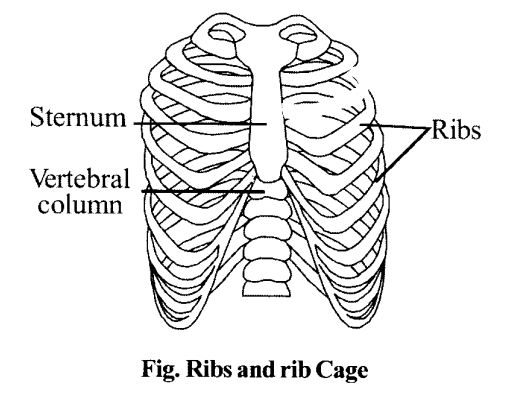
We hope the NCERT Solutions for Class 11 Biology at Work Chapter 20 Locomotion and Movement, help you. If you have any query regarding NCERT Solutions for Class 11 Biology at Work Chapter 20 Locomotion and Movement, drop a comment below and we will get back to you at the earliest.